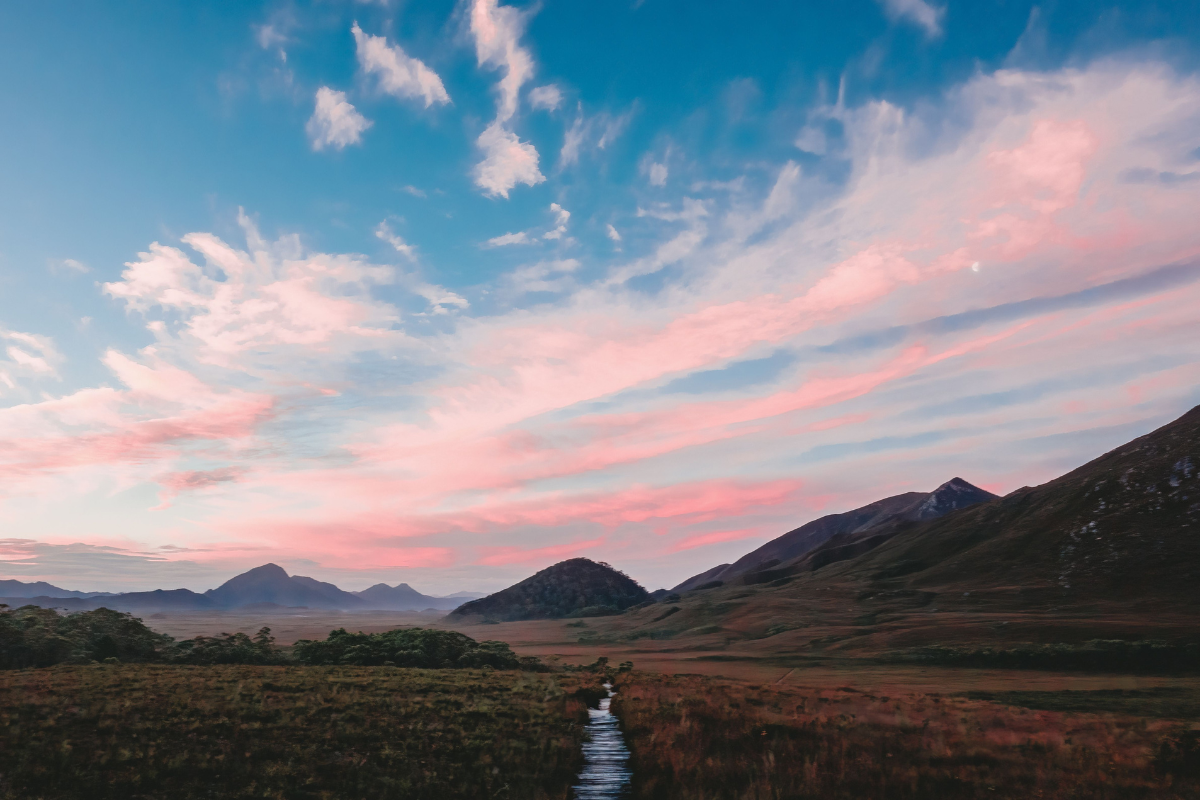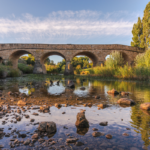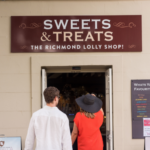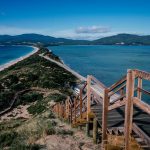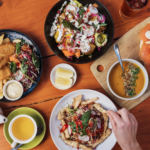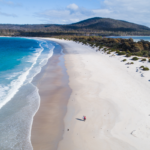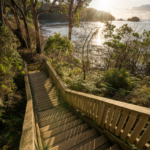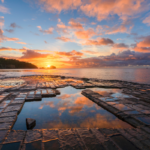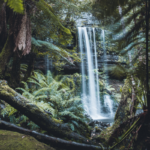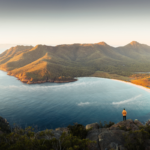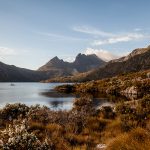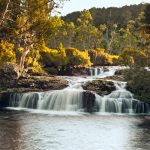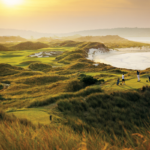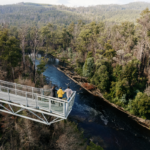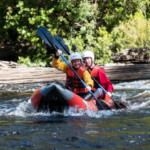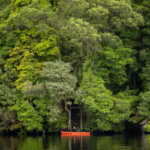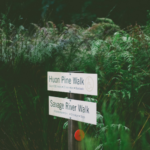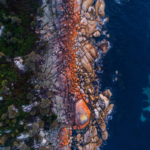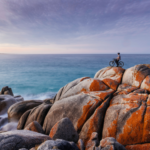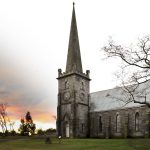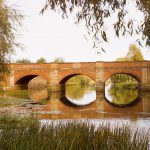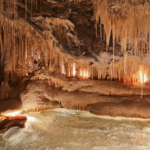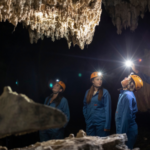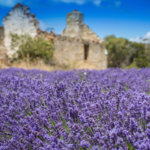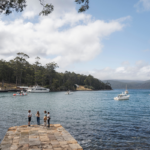Looking to explore more of Tasmania? Plan the ultimate road trip with our guide to the best towns to visit!
Sometimes the best places to see are outside the confines of a capital city, and that goes especially for Hobart and its twin rival Launceston. The main reason for this is because the chances of running into hordes of tourists are remote and, in some cases, even locals are nonexistent. Now doesn’t that sound peaceful!
But as well as seeking peace, we also seek entertainment. Whether that be in the shape of beautiful landscapes, stunning architecture, quirky shop outlets or residential areas sporting weird names. Below, in this road trip itinerary travel guide, you’ll find a list of all of the best towns in Tasmania to visit.
So, pack up the car and be sure to charge your camera as we take you on an adventure with our ultimate travel itinerary to the best towns to visit on your Tasmania road trip!
Richmond Village
- Richmond Bridge, Tasmania. Photographed by Poon Wai Nang. Image via Tourism Tasmania.
- Sweets and Treats, Richmond Village, Tasmania. Photographed by Alastair Bett. Image via Tourism Tasmania,
Found just 25 minutes from Hobart, the little township of Richmond Village specialises in well-maintained Georgian architecture, old style lollies from Sweets and Treats, The Puzzle People jigsaw shop and even an artisan cheese shop, Wicked Cheese. And, if you happen to be in town on a Saturday, locals and visitors alike come together for the popular Richmond Good Food Market. Don’t forget to seek out the popular Richmond Bridge, a piece of architecture that looks like a scene out of a painting. There are also plenty of things to see and do on your stop like the Old Hobart Town Model Village that showcases a model depiction of what Hobart looked like in the 1820s and, there’s even Zoodoo Zoo – a wildlife park located five kilometres north-west of the village.
Bruny Island
- Bruny Island Isthmus. Image by Tamara Thurman via Unsplash.
- Bruny Island Cruises Seafood Restaurant. Photography by Adam Gibson. Image via Tourism Tasmania
This little island directly south of Hobart is in itself a mini holiday destination. And, after you visit, we guarantee that it will be the highlight of your ultimate road trip in Tasmania. While it is possible to make it a day trip, Bruny Island can also pass off as a weekend getaway. There’s scenic flights, safaris, expeditions and nature tours to undertake. Allowing you to explore at your own pace, some notable points of interest is the Bruny Island Neck that features a stretching beach habitat that sees fairy penguins return to their burrows at dusk, along with timber stairs leading to a 360-degree lookout and an indigenous memorial for the Nuenonne people, the original owners of the land.
Discover Tasmania’s very own slice of heaven with our Ultimate Travel Itinerary Guide to Bruny Island.
Maria Island
- Ocean Beach, Maria Island, Tasmania. Photographed by Stu Gibson. Image via Tourism Tasmania.
The great thing about Maria Island is the very limited number of residents, making it the perfect destination to truly get away from the hustle and bustle. To get to Maria Island, simply drive up to Triabunna and catch a ferry over the sea. The best way to get around this secluded is with a bike or partake in a cruise. Some notable points of interest here are the Painted Cliffs (visit at low tide), Fossil Cliffs, Four Mile Creek and Frenchs Farm. Also, if you have the time and you extend your stay on Maria Iland, head down to Haunted Bay to see the red rocks and maybe even some penguins depending on the time you arrive. Please Note: Bring plenty of food and drink as this island has no food shops.
Eaglehawk Neck
- Tessellated Pavement State Reserve, Eaglehawk Neck, Tasmania. Photographed by Luke Tscharke. Image via Tourism Tasmania.
- Tessellated Pavement, Eaglehawk Neck, Tasmania. Photographed by Luke Tscharke. Image via Tourism Tasmania.
Continuing on your Tasmanian road trip itinerary, be sure to stop by for an hour or two at Eaglehawk Neck. Perfect for toilet and tea breaks, Eaglehawk Neck is also the home to the famous tessellated rocks along the north end, with the neck of the town itself in the middle, and a treasure chest of goodies in the south. After exploring the natural tessellated seaside rocks, head to the south suburb of Doo Town where each of the houses are named featuring the word “doo” in it. Alternatively, there is a blowhole and the Tasman Arch and Devil Kitchen.
Mount Field National Park
- Russell Falls, Mount Field National Park, Tasmania. Photographed by Off the Path. Image via Tourism Tasmania.
If you’ve ever wanted to hear the cascading sound of one of Australia’s Most Amazing Waterfalls, tucked away inside Mount Field National Park you’ll find the famed Russell Falls. This multi-tiered waterfall shrouded by greenery is the perfect way to immerse yourself in the beauty that is Mount Field National Park. On top of the cascading beauty, travellers can partake on the Tall Trees Walk that was nmed after its sky-climbing canopies or, alternatively, take a 16 kilometre trek up the mountain to see Lake Dobson. If you visit during the colder months, you’ll be able to spot a snow-covered hill just awaiting adrenaline fuelled skiers.
Freycinet National Park
- Wineglass Bay, Freycinet Tasmania. Photographed by Jason Charles Hill. Image supplied via Tourism Tasmania Visual Library.
On the east coast of Tasmania sits another national park, unique in its own landscape. It’s a peninsula featuring some stunning scenery, like Wineglass Bay, named simply for its wine glass shape. Welcome to Fretcinet National Park! On the left, as you walk over from the carpark, there are the pink granite peaks of Hazards Range. There’s also Sleepy Bay, a little nook on the far northeast of the peninsula. And, for the avid trekkers, you can head down south and see the secluded spots like Bryans Beach and Cooks Corner. It is a two-day trek down the peninsula, so take plenty of supplies.
A hidden gem filled with vineyards, luxury accommodation, beaches and a gastronomic dining and drinking scene, explore the region with our Travel Guide to the Freycinet Peninsula, Tasmania.
Cradle Mountain-Lake St Clair National Park
- Cradle Mountain, Tasmania. Sourced from Tourism Australia, Photography by Cultivate Productions.
- Waterfall Cradle Mountain Lodge, Cradle Mountain Tasmania. Photographed by 3523studio. Image via Shutterstock
No road trip in Tasmania is complete without a visit to Cradle Mountain-Lake St Clair National Park. Part of the Tasmanian Wilderness World Heritage Area, Cradle Mountain is one of the largest national parks on the island (Southwest National Park takes that honour). To the left of Cradle Mountain is another national park called Walls of Jerusalem, Granite Tor Conservation Area sits on the right, and in the south-west is Princess River Conservation Area and Tyndall Regional Reserve. And all that means this is a place to truly get lost in. Boasting a unique plethora of rich flora and fauna, we recommend you pack a compass, plenty of supplies and, of course, a camera.
For all of the best things to do and see, take the scenic route with our Ultimate Road Trip Itinerary from Hobart to Cradle Mountain.
Bridport
- Barnbougle, Tasmania. Photographed by Gary Lisbon. Image via Tourism Tasmania.
If you’re wanting to perfect your swing and score a hole in one, Bridport is home to one of Australia’s Top Golf Courses, Barnbougle. This public course along the beachfront of Bridport has front-row views and is renowned internationally. Otherwise, if you’d like a bit of sightseeing, we recommend visiting the Granite Point Conservation Area and see the wonderful blooms of wildflower and the fluttering of birds that come to life during springtime. Finish with a feed at Bridport Bunker Club and you’ll be ready to head on your way!
Geeveston
- Tahune AirWalk, Geeveston, Tasmania. Image via Tourism Tasmania.
- Tahune, Geeveston, Tasmania. Image via Tourism Tasmania.
Over 50 kilometres southwest of Hobart in Geeveston is the Tahune AirWalk – a popular tourist destination that sits alongside the Huon River. The AirWalk is draped midrange within the canopy, showing the spectacular sights of the forest floor and nearby river. There’s also a Hang Glider, a cable-controlled ride that takes thrillseekers on a five-minute tour of the forest. And, if you’re not a fan of heights, you can take the Twin Rivers Adventure where you can traverse the wilderness on a raft or kayak.
Tarkine
- Pieman River, Tarkine Rainforest, Tasmania. Photographed by Jess Bonde. Image via Tourism Tasmania.
- Tarkine Rainforest walk, Tasmania. Photographed by Stu Gibson. Image via Tourism Tasmania.
Welcome to the destination that Tasmanians consider as their secret hideaway – and it really is. You won’t find it on Google Maps, but it’s definitely there. This town, home to Tarkine Rainforest, is best described as an untouched beauty, unparalleled and, ultimately, a magical place to wind yourself down. And while you can traverse the Tarkine on your own (provided necessary cautions are taken care of: plenty of food and water, access to maps and accommodation), you can also travel the wilderness with Tarkine Trails.
Bay of Fires
- Bay of Fires aerial, Tasmania. Photographed by Stu Gibson. Image via Tourism Tasmania.
- Bay of Fires, Tasmania. Photographed by Stu Gibson. Image via Tourism Tasmania.
Such a poetic name for a national park. The Bay of Fires was simply named by Captain Tobias Furneaux when sailing past in 1773. Whether it was because he saw fires lit by Aboriginal tribes scattered along the coast, or to the orange lichen that grows on the granite boulders, we’ll never know. But, nevertheless, it is a sight to see. The Bay of Fires is a conservation area split into three sections: Ansons Bay in the north to Binalong Bay in the south and The Gardens in the middle. Take a day trip, or simply stop by on the way. Make sure to charge your camera!
Southwest National Park
- Southwest National Park, Tasmania. Photographed by Matty Eaton. Image via Tourism Tasmania.
The next stop on your road trip in Tasmania is Southwest National Park. Here you can head to Southport and check out Hastings Caves and Thermal Springs. If you’d rather stay on the road, you can drive down the Gordon River Road and see Lake Gordon and Lake Peddler. Hit the waters and hire a boat to experience the coast’s beauty, then find the inlet near Breaksea Islands and travel inside the wilderness. You could also take a hike inside (provided necessary cautions are taken care of: plenty of food and water, access to maps, accommodation). But, for the ultimate adventure, spend a little money and take a trip with Par Avion to the Southwest Wilderness Camp and stay for three days.
Campbell Town
- St Andrews Church Campbell Town Tasmania. Photographed by Lambos Pavlides. Image via Shutterstock
- Red Brick Bridge, Campbell Town, Tasmania. Photographed by Steve Lovegrove. Image via Shutterstock
It’s not the most holiday-like place to drive to, but it does make a great pit stop. Interestingly, Campbell Town was designed for that purpose back in the 1800s for those travelling between Hobart and Launceston. And while you stretch your legs and refuel, you can take a gander at the town’s teeming colonial history. Take a self-guided tour of the Convict Brick Trail, revealing the individual stories of Tasmanian Convicts, who they were and why they were arrested. Walk over and take a snap of Red Brick Bridge, built by convicts in the 1830s and believed to hold one million bricks. Or, you can even walk through the Campbell Town Museum.
Mole Creek & Chudleigh
- Mole Creek Caves, Tasmania. Photographed by Graham Freeman. Image via Tourism Tasmania.
- Mole Creek Caves, Tasmania.. Image via Tourism Tasmania.
They’re both famous for their honey-making skills with Melita Honey Farm and R. Stephens Honey – a must see and taste when visiting. But, don’t forget, these two towns are surrounded by plenty of natural beauty too. To the north, Alum Cliffs and Gog Range Regional Reserve tower over the Mersey River. To the west, Mole Creek Caves sprawl within the terrain, from King Solomons Cave to Marakoopa Cave. To the south, of course, is Cradle Mountain. And, to the east, you’ll find Three Willows Vineyard and 41° South Tasmania, a farm specialising in salmon and ginseng.
Port Arthur
- Port Arthur Lavender, Tasmania. Photographed by Port Arthur Lavender. Image via Tourism Tasmania.
- Port Arthur, Tasmania. Image via Tourism Tasmania.
Unfortunately, made famous by a mass shooting in 1996 where 35 people lost their lives. It saw the creation of sweeping gun laws making Australia one of the safest gun ownership countries in the world. But today, Port Arthur still stands as a window into Tasmania’s dark history. From a timber station to a convict settlement, to the coal mines where convicts worked underground extracting coal. But, like everywhere in Tasmania, there’s also the natural landmarks like one of the Best Lavender Farms in Australia, Port Arthur Lavender.
Embark on a trip like no other with our list to the 10 Unique Getaway Gems to Discover around Tasmania. And, be sure to tuck in somewhere with some charm thanks to our guide to the 10 Best and Most Unique Boutique Hotels in Tasmania.
We acknowledge the traditional owners of country throughout Australia and recognise their continuing connection to land, waters 9and culture. We pay our respects to their elders past, present and emerging.

